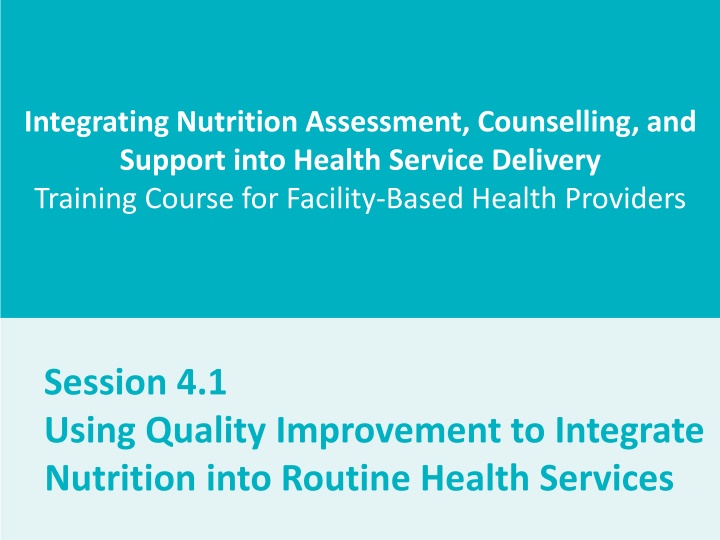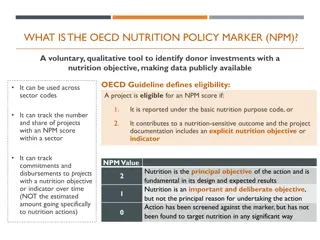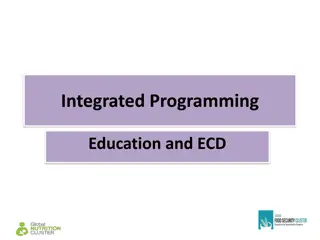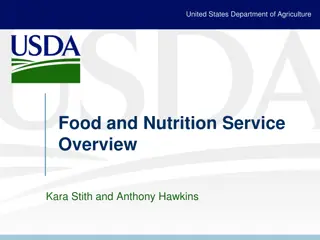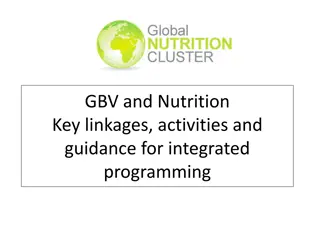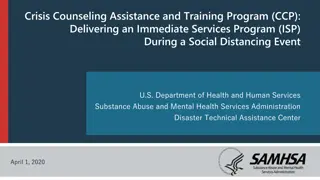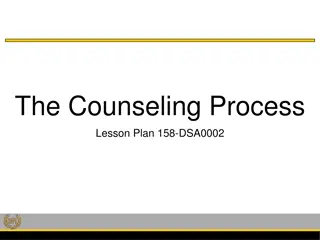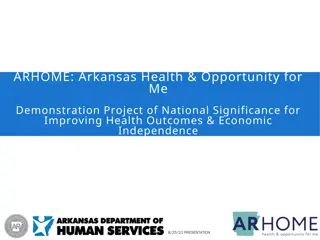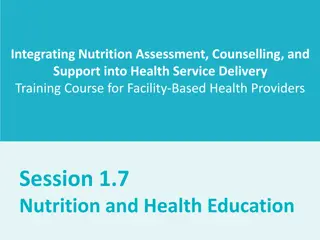Integrating Nutrition Assessment and Counseling: Quality Improvement in Health Services
This training course focuses on integrating nutrition assessment, counseling, and support into routine health services using quality improvement methods. Participants will learn to explain the concept of quality improvement, develop a plan for integrating nutrition services, and understand key principles of quality improvement in the health sector. Sessions cover topics such as defining quality and quality improvement, brainstorming on quality in healthcare, and emphasizing client-focused, data-driven teamwork for improving health services.
Download Presentation

Please find below an Image/Link to download the presentation.
The content on the website is provided AS IS for your information and personal use only. It may not be sold, licensed, or shared on other websites without obtaining consent from the author.If you encounter any issues during the download, it is possible that the publisher has removed the file from their server.
You are allowed to download the files provided on this website for personal or commercial use, subject to the condition that they are used lawfully. All files are the property of their respective owners.
The content on the website is provided AS IS for your information and personal use only. It may not be sold, licensed, or shared on other websites without obtaining consent from the author.
E N D
Presentation Transcript
Integrating Nutrition Assessment, Counselling, and Support into Health Service Delivery Training Course for Facility-Based Health Providers Session 4.1 Using Quality Improvement to Integrate Nutrition into Routine Health Services
Session Objectives By the end of the session, participants will be able to: Explain the concept of quality improvement Describe how quality improvement can be used to integrate NACS into routine health services Develop a plan for integrating NACS within existing health care system Integrating Nutrition Assessment, Counselling, and Support into Health Service Delivery 2
Quality Improvement: Key Terms and Principles Integrating Nutrition Assessment, Counselling, and Support into Health Service Delivery
Brainstorm What does quality mean to you? What does quality improvement mean to you in relation to health care? Integrating Nutrition Assessment, Counselling, and Support into Health Service Delivery 4
Define Quality and Quality Improvement(QI) Quality The extent to which health care, services, systems, and specification/programmes conform to national or internal standards/requirements. QI A management approach to improving and maintaining quality that emphasizes internally driven and relatively continuous assessments of potential causes of quality defects followed by action at either avoiding decrease of quality or correcting it at an early stage. Integrating Nutrition Assessment, Counselling, and Support into Health Service Delivery 5
Four Key Principles of QI 1. Client focus 2. Focus on systems and processes: oSystem oProcess 3. Testing changes and emphasizing the use of data 4. Teamwork Integrating Nutrition Assessment, Counselling, and Support into Health Service Delivery 6
Health Sector Quality Improvement Framework Integrating Nutrition Assessment, Counselling, and Support into Health Service Delivery 7
The Framework for Health Care Quality Improvement How QI Integrates Content of Care and the Process of Providing Care Content of Care: Process of Care: Output/Outcome: What is done How it is done Improved quality of care and health status (e.g., standards developed and applied) Norms Standards Protocols Guidelines Quality improvement approaches Cycle of learning and improvement Integrating Nutrition Assessment, Counselling, and Support into Health Service Delivery 8
Steps in Quality Improvement Integrating Nutrition Assessment, Counselling, and Support into Health Service Delivery 9
Model for Improvement What are we trying to accomplish? How will we know that a change is an improvement? What changes can we make that will result in improvement? Integrating Nutrition Assessment, Counselling, and Support into Health Service Delivery 10
Four Steps for QI 1. Identify the problem 2. Analyse the problem 3. Develop possible solutions to the problem 4. Test/implement the possible solution Integrating Nutrition Assessment, Counselling, and Support into Health Service Delivery 11
Step 1. Identify the Problem QI starts by asking questions to identify the gap between the actual and desired performance: o What is the problem? o How do you know that it is a problem? o How frequently does it occur or how long has it existed? o What are the effects of this problem? o How will you know when it is resolved? Ways to identify the problem include: o Survey data o Review of records o Observation o Client feedback Integrating Nutrition Assessment, Counselling, and Support into Health Service Delivery 12
Step 2. Analyse the Problem The purpose is to measure performance of the process or system that produces the effect. Analysis involves answering the following questions: o Who is involved or affected? o Why, when, where does the problem occur? o What happens when the problem occurs? Analysis tools and techniques include: o Flow charts o Cause-and-effect (fishbone) diagrams o Review of existing data Integrating Nutrition Assessment, Counselling, and Support into Health Service Delivery 13
Step 3. Develop Possible Solutions (Changes) Changes/possible solutions are based on data, knowledge, and beliefs about the problem s likely causes and solutions. QI teams should hypothesize what changes will improve the problem. Integrating Nutrition Assessment, Counselling, and Support into Health Service Delivery 14
Step 4. Test and Implement Proposed solutions should be tested on a small scale over a specific period to determine whether they are effective. Based on the results, the team can decide to: A) Abandon B) Modify C) Implement the solution Integrating Nutrition Assessment, Counselling, and Support into Health Service Delivery 15
1. Identify 2. Analyze 3. Develop PLAN ACT 4. Implement DO STUDY Integrating Nutrition Assessment, Counselling, and Support into Health Service Delivery 16
QI Tools Commonly Used Integrating Nutrition Assessment, Counselling, and Support into Health Service Delivery 17
1) Flow chart Flow chart A type of diagram that represents an algorithm, workflow or process, showing the steps as boxes of various kinds, and their order by connecting them with arrows. This diagrammatic representation illustrates a solution model to a given problem. Integrating Nutrition Assessment, Counselling, and Support into Health Service Delivery 18
Example of a Flowchart Process map for HIV clinic (client flow)
2) Run Chart/Time Series Chart This tool tracks the performance of a process over time. Helps detect shifts, trends, or other nonrandom variations in the process. o Allows user to react quickly to changes and identify underperformance. o Helps determine if improvement is sustained. Visual display makes it easier to see and understand trends and patterns. Integrating Nutrition Assessment, Counselling, and Support into Health Service Delivery 20
How to Use Run Chart Step 1. Determine the purpose of the chart and the data to be monitored, collected, and analyzed. Select the time interval (minute, hour, day, month). Step 2. Collect the data that will be plotted. Step 3. Plot time on the horizontal axis (typically located at the bottom). Step 4. Label the vertical axis and plot the data collected in step 2 on the vertical axis (typically located on the left-hand-side). Step 5. Title the chart. Indicating which direction is better with an up or down arrow may be helpful. 21 Integrating Nutrition Assessment, Counselling, and Support into Health Service Delivery
Example of Run chart with annotation % of children whose nutritional status is assessed using mid- upper arm circumference (MUAC) 100 90 80 70 Nutrition training 60 50 Delivery of commodity % 40 30 20 10 0 w-14 w1 w3 w5 w7 w9 w-8 w-6 w-4 w-2 w-20 w-18 w-16 w-12 w-10 w11 w13 w15 w17 w19 w21 w23 w25 w27 22
Elements of a Time-Series Chart 23 Integrating Nutrition Assessment, Counselling, and Support into Health Service Delivery
3. Documentation Journal Detailed record of changes and results for reviewing and reflecting on the QI work. o What you are trying to accomplish and why o Changes implemented with notations of their effectively and dates o Graphs of data and results o Annotated run charts Integrating Nutrition Assessment, Counselling, and Support into Health Service Delivery 24
QI Documentation Journal cont. The journal has three parts: Part 1: Document what you are trying to accomplish and why? Part 2: Worksheet to list each of the changes you want to implement and how you will measure (Indicator)- Action plan Part 3: Space for graph for data or result. Annotate your run charts with your changes to see impact (A copy of QI journal in Annex, Reference Manual) Integrating Nutrition Assessment, Counselling, and Support into Health Service Delivery 25
Documentation Journal: Simple Action Plan Action Plan for Nutrition Integration Facility: Date Prepared:
Using QI to Integrate NACS into Routine Health Services Integrating Nutrition Assessment, Counselling, and Support into Health Service Delivery 27
Seven Steps of NACS Implementation Nutrition education Nutrition assessment Nutrition classification Nutrition counselling Specialized food products Follow-up Community links Integrating Nutrition Assessment, Counselling, and Support into Health Service Delivery 28
Small Group Work Form groups based on the facility you work with. Together develop an action plan for integrating and/or improving quality of nutrition at your facility. Focus on assessment and classification. Integrating Nutrition Assessment, Counselling, and Support into Health Service Delivery 29
Small Group Work: Key Questions Draw a flow chart of your facility. What are we trying to accomplish? What changes could be made to achieve this goal? Use the journal to complete the information below. How will we know the change has led to improvement? What might this improvement look like in your facility? What specific intervention could be done in the next 2 weeks to make these improvements? Who will be responsible for the different activities involved in each step? How will you know that the change is working? Integrating Nutrition Assessment, Counselling, and Support into Health Service Delivery 30
Summary QI is a management approach to improving and maintaining quality that emphasizes internally driven and relatively continuous assessments of potential causes of quality defects followed by action at either avoiding decrease of quality or correcting it at an early stage. QI has four key principles: client focus, focus on systems and processes, testing changes and emphasizing the use of data, and teamwork. QI is based on the PDSA cycle. QI tools includes flow chart/run chart and documentation journal. QI is useful for smooth integration of nutrition into routine service delivery. Integrating Nutrition Assessment, Counselling, and Support into Health Service Delivery 31
Thank you! Questions, additions, or clarifications?
